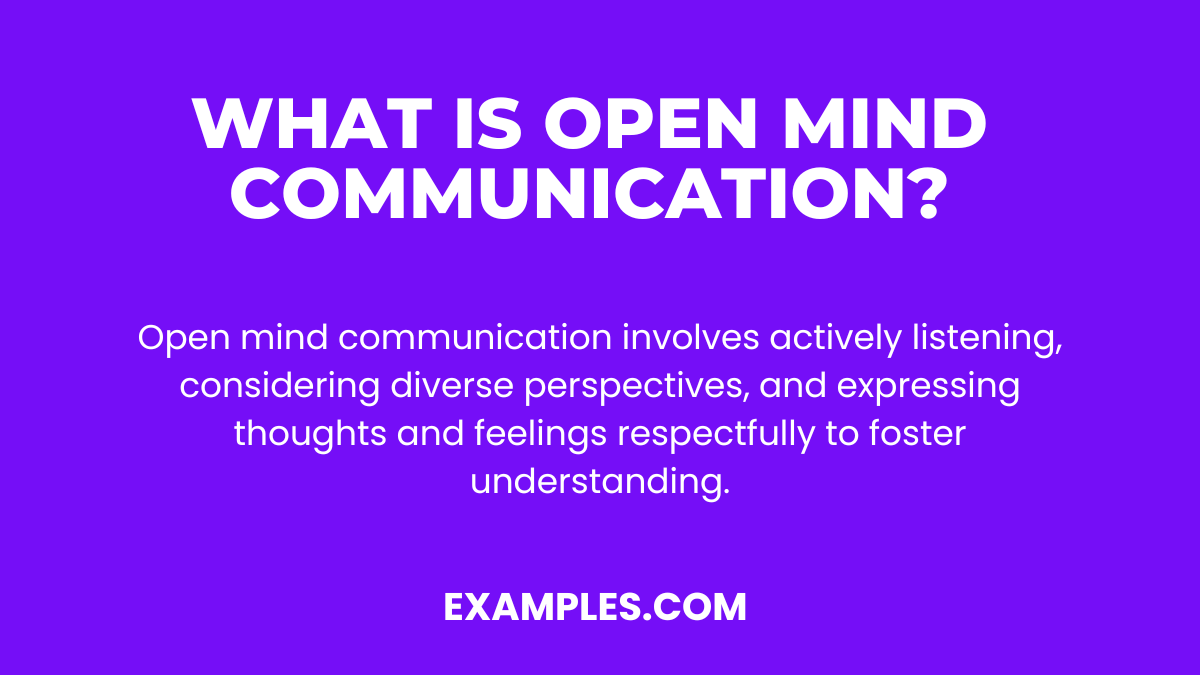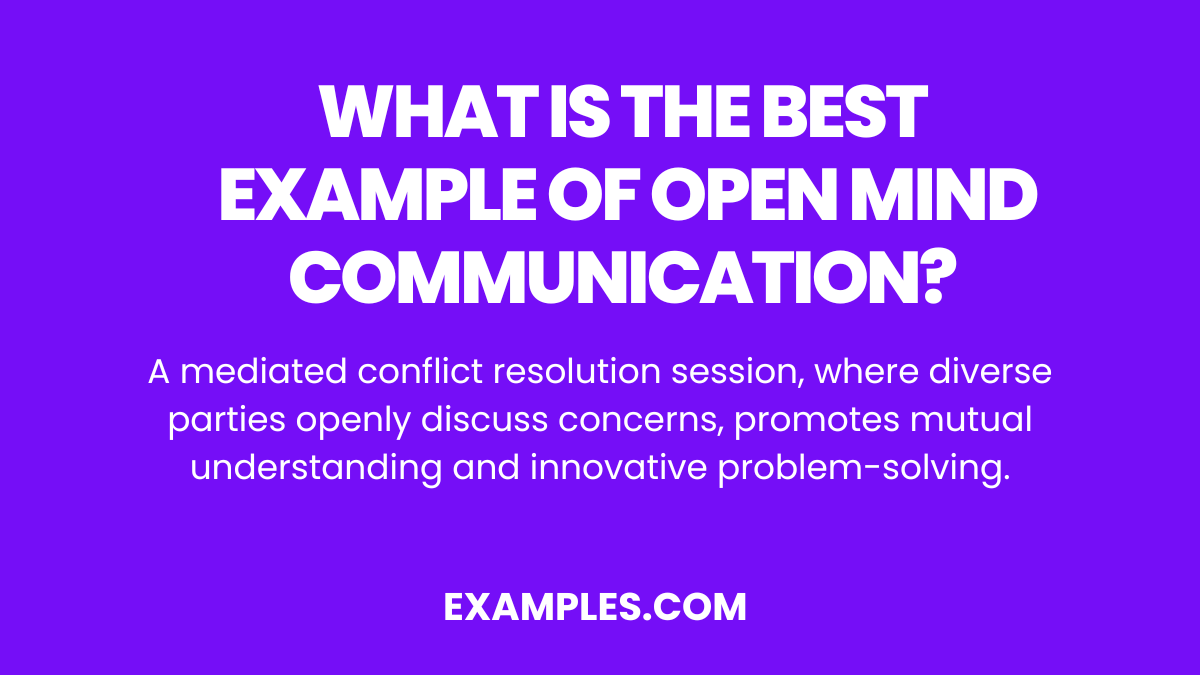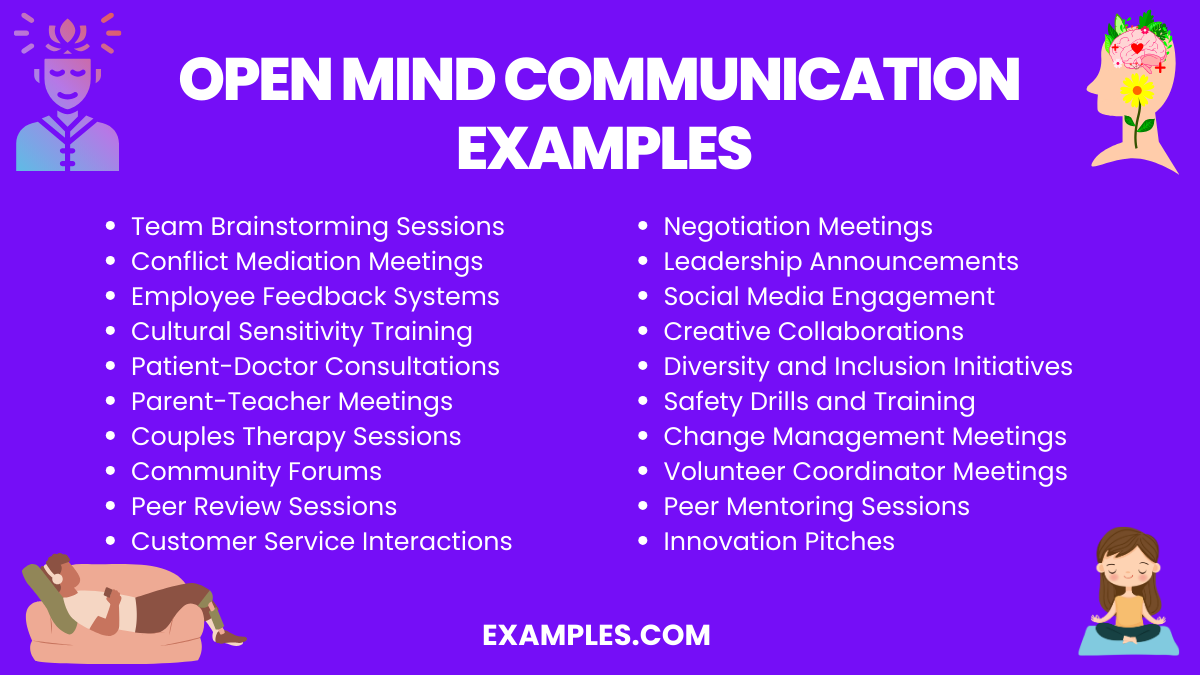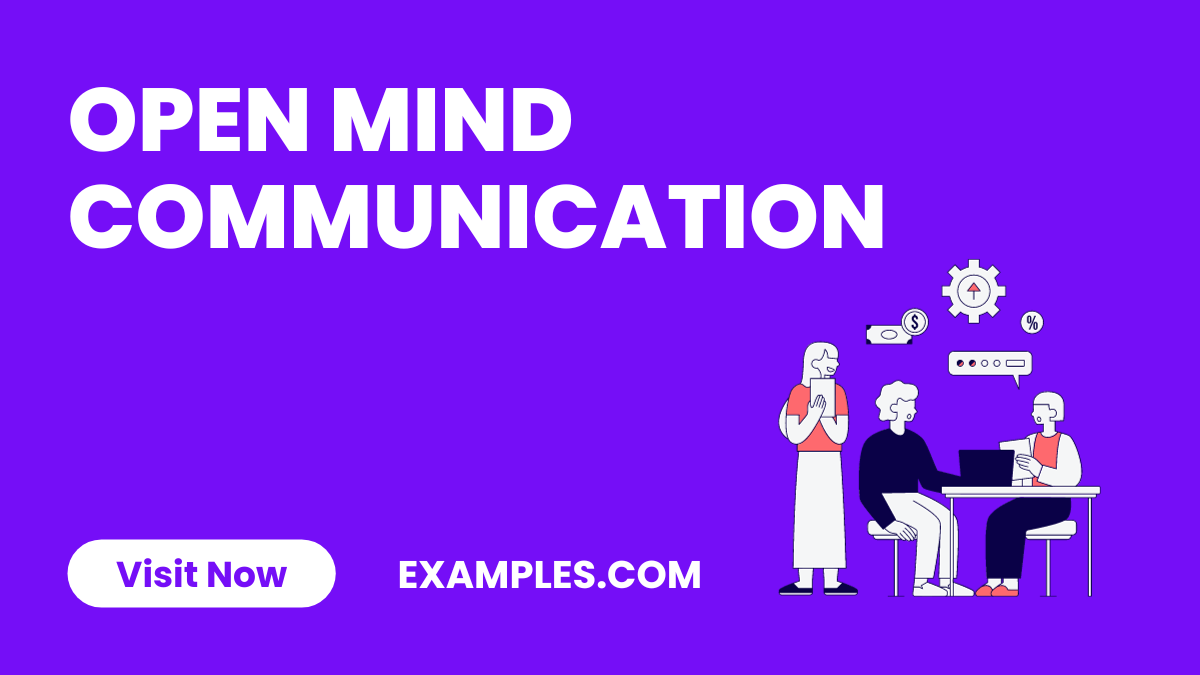19+ Open Mind Communication Examples
Unlock the potential of open-minded communication with this complete guide. Discover how embracing diverse perspectives can lead to more innovative solutions and stronger relationships. Dive into various Communication Examples that highlight the effectiveness of open dialogue, empathetic listening, and transparent exchanges in fostering a more inclusive and collaborative environment.
Download Open Mind Communication for Adaptive Business Style
What is Open Mind Communication? – Meaning

Open mind communication refers to the practice of engaging in dialogue with a willingness to consider different perspectives and ideas. It involves listening actively, suspending judgment, and expressing thoughts and feelings in a way that is respectful and receptive to others. This form of Open Communication fosters a more inclusive and understanding environment, whether in personal relationships, the workplace, or broader community interactions.
What is the Best Example of Open Mind Communication?

One of the best examples of open mind communication is a mediated conflict resolution session. In this setting, individuals with differing viewpoints come together to discuss their concerns openly and honestly. Facilitators ensure that each party listens to the other without prejudice, considering their perspective and feelings. This process often leads to a mutual understanding, innovative problem-solving, and a strengthening of relationships. It showcases how open mind communication can transform conflicts into opportunities for growth and collaboration.
20 Open Mind Communication Examples

Explore 20 unique and impactful examples of open mind communication. Each represents a scenario where embracing diverse perspectives, active listening, and empathetic dialogue leads to better understanding and collaboration. By understanding the causes behind communication challenges and applying targeted fixes, individuals and organizations can significantly improve their communication dynamics, reaping the Open Communication Benefits. Whether it’s enhancing Open Communication in Relationship, ensuring effective teamwork in the workplace, or fostering a culture of honest communication, the principles of open mind communication are universally applicable and beneficial. Understand the causes behind communication barriers and discover effective strategies to enhance Open Communication in the Workplace, improve relationships, and foster a culture of transparency and respect.
- Team Brainstorming Sessions: Diverse ideas flourish in open brainstorming sessions. Cause: Varied backgrounds and experiences. Fix: Encourage all to contribute, ensuring a respectful and inclusive environment.
- Conflict Mediation Meetings: Effective for resolving disputes. Cause: Misunderstandings or differing viewpoints. Fix: Implement active listening and empathetic responses to bridge gaps.
- Employee Feedback Systems: Critical for organizational growth. Cause: Need for continuous improvement. Fix: Create anonymous feedback mechanisms to promote Honest Communication.
- Cultural Sensitivity Training: Enhances workplace harmony. Cause: Increasingly diverse workforce. Fix: Regular training on cultural awareness and inclusive communication.
- Patient-Doctor Consultations: Vital for quality care in Open Communication in Healthcare. Cause: Need for accurate diagnosis and treatment. Fix: Encourage patients to openly share all health concerns.
- Parent-Teacher Meetings: Fosters child’s academic and social growth. Cause: Concern for student’s welfare. Fix: Open dialogue focusing on student’s best interest.
- Couples Therapy Sessions: Strengthens Importance of Open Communication in Relationship. Cause: Miscommunication or unresolved issues. Fix: Guided discussions to understand each partner’s perspective.
- Community Forums: Encourages civic engagement. Cause: Community issues and development. Fix: Create platforms for residents to voice concerns and suggestions.
- Peer Review Sessions: Enhances academic and professional work. Cause: Need for constructive feedback. Fix: Promote a culture of constructive and supportive feedback.
- Customer Service Interactions: Directly impacts client satisfaction. Cause: Customer queries or complaints. Fix: Train staff in empathetic and solution-oriented communication.
- Negotiation Meetings: Fundamental in business dealings. Cause: Differing objectives and needs. Fix: Focus on win-win solutions and understanding the other party’s needs.
- Leadership Announcements: Shapes organizational culture. Cause: Need for transparency and guidance. Fix: Clear, honest, and motivational messaging.
- Social Media Engagement: Builds brand reputation. Cause: Public relations and customer interaction. Fix: Maintain active, positive, and open interactions online.
- Creative Collaborations: Essential in arts and innovation. Cause: Synergy of different creative minds. Fix: Foster an environment where all ideas are welcome.
- Diversity and Inclusion Initiatives: Promotes equality and respect. Cause: Historical underrepresentation and bias. Fix: Ongoing education and open forums for discussion.
- Safety Drills and Training: Ensures preparedness and safety. Cause: Risk of emergencies. Fix: Regular, clear communication about procedures and importance.
- Change Management Meetings: Navigates organizational changes. Cause: Business growth or restructuring. Fix: Transparent communication about changes and their impacts.
- Volunteer Coordinator Meetings: Boosts community service efforts. Cause: Coordination of volunteer activities. Fix: Clear roles, expectations, and appreciation for contributions.
- Peer Mentoring Sessions: Supports personal and professional development. Cause: Desire for growth and guidance. Fix: Open sharing of experiences and advice.
- Innovation Pitches: Encourages new ideas and ventures. Cause: Need for organizational innovation. Fix: Provide a supportive platform for presenting and discussing new ideas.
Open Mind Communication in Workplace
Embrace Open Mind Communication in the Workplace to transform your team dynamics and productivity. This approach involves active listening, inclusivity, and continuous feedback, fostering an environment where every employee feels valued and heard. By implementing these practices, workplaces can boost morale, innovation, and overall success.
- Transparent Project Debriefs: After project completion, discuss what worked and what didn’t. “Let’s openly share our thoughts to improve future projects.”
- Multidisciplinary Team Meetings: Encourage teams from different departments to share insights. “Your unique perspectives are valuable to our project’s success.”
- Cross-Training Sessions: Swap roles or shadow different departments to understand various challenges and workflows. “Understanding your role helps me communicate better with the team.”
- Innovation Brainstorms: Regularly schedule sessions for employees to suggest innovative ideas freely. “All ideas are welcome here; let’s think outside the box together.”
- Cultural Awareness Days: Celebrate and learn from the diverse cultures present in your workplace. “Sharing our backgrounds enhances our collective Open Communication in Leadership.”
Open Mind Communication for Students
Open Mind Communication for Students is pivotal in shaping how young minds engage with the world. It promotes critical thinking, empathy, and effective interpersonal skills, setting the foundation for lifelong learning and understanding. Incorporating Open Communication Quotes, encouraging Open Mind Communication, and strategies on How to Promote Open Communication can significantly impact the development of open communication skills. Additionally, understanding and appreciating the nuances of Open Communication in Family, and how Open Communication with Parents and Open Communication with Child can foster healthier relationships, are essential components of building a comprehensive communication skill set.
- Group Projects with Diverse Teams: Mix students from different backgrounds and skills. “Let’s use our diverse perspectives to tackle this project.”
- Peer Mediation Programs: Train students to help mediate minor conflicts among peers. “Your viewpoint is important; let’s find a common ground.”
- Public Speaking Clubs: Encourage students to express their thoughts and ideas in front of others. “Your voice is powerful; share your thoughts confidently.”
- Cultural Exchange Pen-Pals: Connect with students from other countries to exchange letters. “Learning about your culture helps me understand different perspectives.”
- Feedback Circles: Create a safe space for students to give and receive constructive feedback. “I appreciate your feedback; it helps me grow.”
What is the Essence of Open Mind Communication in Building Relationships?
At the core of building lasting relationships is the essence of open mind communication. It’s about embracing diverse viewpoints, fostering empathy, and actively listening to deepen understanding and connection.
- Active Listening: Truly listen to understand, not just to respond. This builds deeper empathy and trust in relationships, akin to Open Communication with Patients, where understanding and empathy are vital.
- Non-Judgmental Attitude: Approach conversations with an open heart, free from preconceptions or biases. This encourages more honest and meaningful exchanges.
- Constructive Feedback: Offer feedback that is supportive and aimed at growth, just as you would in nurturing Open Communication with Students, focusing on development and encouragement.
- Empathetic Engagement: Put yourself in others’ shoes to understand their perspective, enhancing the bond and mutual respect in the relationship.
- Continuous Personal Development: Strive to Improve Communication Skills continually, recognizing that relationships evolve and Communication Needs may change over time.
How Can Open Mind Communication Improve Teamwork and Collaboration?
Open mind communication is a cornerstone of effective teamwork and collaboration. It encourages a free exchange of ideas, respect for diverse opinions, and a collective approach to problem-solving.
- Foster a Safe Environment: Create a space where team members feel safe to express their thoughts and ideas, similar to promoting Open Communication with Colleagues, where trust and safety are paramount.
- Encourage Diverse Perspectives: Welcome and value different viewpoints as a source of strength and creativity in team projects.
- Regular Team Building Exercises: Engage in activities that promote understanding and trust among team members, essential for solid collaboration.
- Transparent Goal Setting: Clearly communicate team goals and how each member contributes, akin to clear and goal-oriented Open Communication with Manager, ensuring everyone is aligned and motivated.
- Recognition and Appreciation: Regularly acknowledge and celebrate the contributions of team members, fostering a positive and inclusive team culture.
What Strategies Promote Open Mind Communication in Diverse Workplaces?
Promote open mind communication in diverse workplaces through inclusive policies, cultural sensitivity training, and fostering an environment of respect, akin to Open Communication with Stakeholders.
Why is Open Mind Communication Essential in Resolving Conflicts?
Open mind communication is vital in conflict resolution as it promotes understanding, reduces biases, and facilitates empathetic solutions, contrasting Open Communication vs Closed Communication.
What Role Does Active Listening Play in Open Mind Communication?
Active listening is fundamental in open mind communication, as it ensures understanding, builds trust, and forms the basis for meaningful dialogue, bridging gaps seen in Open Communication vs Direct Communication.
In conclusion, open mind communication is the cornerstone of constructive dialogue, promoting understanding and empathy. Through real-life examples, we’ve seen its positive effects on relationships and problem-solving. Recognizing signs of closed-mindedness is crucial, but the solution lies in cultivating active listening, empathy, and a willingness to embrace diverse perspectives. By doing so, we can foster a culture of open mind communication that enhances connections and leads to meaningful resolutions.



